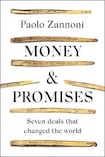
I associate tallies with elections, meaning the rows of numbers in spreadsheets tracking votes in different parts of a constituency. So it was news to me to read that, for about 600 years, tallies were physical records of commerce and debts in England.
These records were created through notches and marks on sticks of willow or hazel-wood. A record included the name of the parties involved in the trade, details of the transaction and when it occurred. This stick or “tallie” could be broken in half. The smooth joining-together of the broken tallies confirmed transactions. These sticks were also used to pay debts, to help with the payment of taxes and to create debt markets for monarchs and parliaments.
This is a distinctive example of the creation of money included in Money & Promises. Similar stories, from different periods of historical change, are the focus of this work, a study of “seven deals that changed the world”. For the author, after a successful career in banking, this is a labour of love.
The story begins in 12th-century Pisa, continues into the early years of the Bank of England, and includes the increasingly familiar efforts by Alexander Hamilton and Thomas Jefferson to establish a public bank in North America. Each chapter examines the efforts of societies, across geography and time, to create a broadly accepted unit of payment and value.
READ MORE
This is a beautiful, well-illustrated book that is far from a coffee-table ornament. The study and learning is serious, the tone is light but the academic rigour is clear. These studies are frequently complex, so some could have benefited from further explanation.
The message of these examples of how currency created is clear and of profound economic importance. Money is not just the creation of central banks and governments, “sovereign currencies everywhere are made up mostly of bank debts, backed up by clients’ promises and obligations”. Money is “debt backed by debt”.
A concluding chapter tying together the different strands of these stories would have made this a more complete work. However, any reader interested in the curious origins of money and why finance and banks matter for economies will find this an enlightening and enjoyable book.
Paschal Donohoe is the Minister for Public Expenditure and president of the Eurogroup















